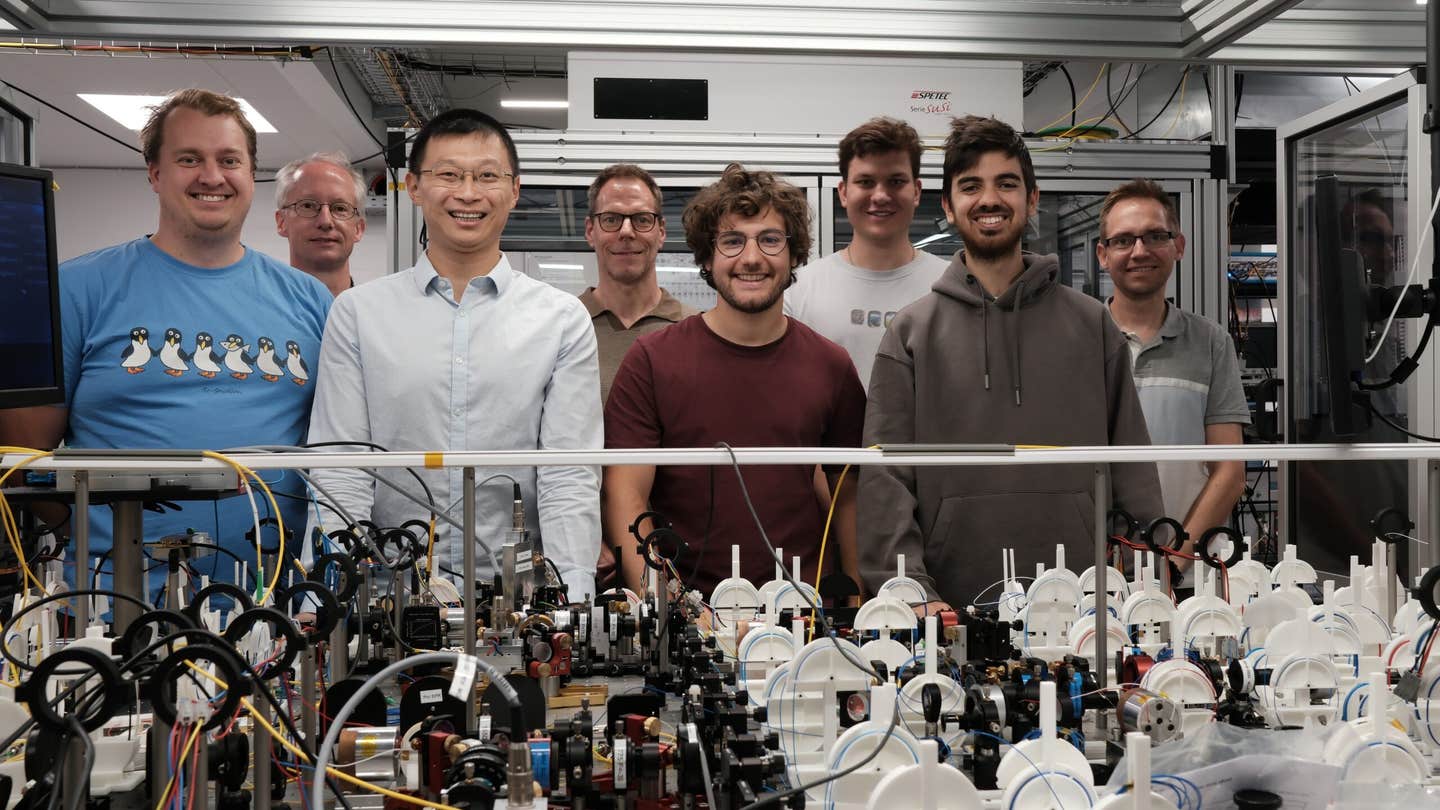New molecule targets and destroys harmful RNA linked to cancer and aging
Scientists create a molecular tool that destroys RNA driving cancer and aging, offering a new path for precision medicine.

 Edited By: Joshua Shavit
Edited By: Joshua Shavit

Researchers at Hebrew University have built a molecule that erases harmful RNA linked to cancer and aging. (CREDIT: Shutterstock)
Within each cell, there is a constant struggle between life-sustaining molecules and molecules that could hasten its demise. For the first time, scientists have created a molecule that can identify and erase one of the toughest kinds of RNA linked to cancer and the aging process.
Their work, published in Advanced Science and conducted by Dr. Raphael I. Benhamou, Elias Khaskia, and Dipak Dahatonde in Dr. Shana Kelley’s lab at the Hebrew University of Jerusalem, introduces a stunning new system, RIBOTAC, or Ribonuclease Targeting Chimera.
RIBOTACs act like a precision-guided missile for faulty RNA. In this study, researchers built a molecule that binds to a complex RNA called TERRA (Telomeric Repeat–Containing RNA) and recruits the cell’s own enzyme, RNase L, to eliminate it. “We’ve built a tool that acts like a guided missile for bad RNA," said Benhamou. "It can go find TERRA in a cancer cell and remove it from the cell without harming any healthy parts of the cell.”
Anticipating TERRA’s Double Life
The ends of every chromosome are protected by DNA repeats known as telomeres, which prevent chromosomes from adhering and/or unraveling. TERRA molecules are RNA strands that are copied from latomeric DNA. In healthy cells, they help stabilize chromosomes and ensure proper aging; if TERRA is no longer regulated correctly, they can help cancer cells develop and survive by supporting telomere lengthening to enable infinite doubling.
These long RNA strands can fold into complex knot-like shapes called G-quadruplexes, which are resistant to normal cellular degradation. Eventually, the accumulation of RNA knots can cause genetic instability. And, subsequently, increase the rate of cancer development. Scientists have known for a long time, TERRA is involved in both cellular aging and tumor formation, but no one had figured out how to directly disarm TERRA, until now.
Designing a Molecular Eraser
Drugs have traditionally focused on the targeting of proteins and not RNA. And, while gene-editing tools can alter DNA, they cannot alter the passing RNA molecules that float in the cell. The new RIBOTAC approach changes that. The molecule is designed with two pieces attached. One section targets the unique G-quadruplex shape of TERRA and the other attracts RNase L, the cell's own RNA-cutting enzyme.
The researchers first discovered a small compound called Q2 that tightly but selectively binds to TERRA's G-quadruplexes. The next challenge was to attach Q2 to a chemical arm that is attractive to RNase L, thus creating the Q2-RIBOTAC molecule. Once the compound attaches to TERRA, the cell's own enzyme cleaves the RNA, effectively erasing it.
The researchers tested Q2-RIBOTAC against human cancer cell lines, including HeLa and U2OS, and observed that the compound reduced TERRA levels dramatically. Even when the scientists blocked RNA synthesis, Q2-RIBOTAC destroyed all of the existing TERRA, thus demonstrating that Q2-RIBOTAC worked by degrading TERRA rather than preventing synthesis. When viewed under the microscope, the researchers observed Q2-RIBOTAC move to the nucleus of the cell, where telomeric RNA lies, and cause the removal of faulty RNA.
Rerouting the Cell’s Defense Mechanism
Typically, RNase L functions as a system of cellular defense capable of destroying viral RNA during an infection. By leveraging this naturally occurring and abundant enzyme and directing it to target human RNA, the researchers have discovered a mechanism for the cells' own machinery to clear unnecessary and potentially damaging RNA that contributes to disease.
In their experiments, they found that cells lacking RNase L did not respond to the treatment, confirming that RNase L is a critical component of the mechanism. "We didn't need to invent a new destruction mechanism," Benhamou said. "We just needed to teach the cell how to use its existing tools in other capacities."
Rebalancing the Chromosome Ends
Additionally, when TERRA levels were lowered, the researchers observed improvements in chromosome stability. Imaging with fluorescent tags showed that there were fewer telomere dysfunction-induced foci, which are markers of damage that arise when telomeres become unstable. This indicates we are attempting to restore the delicate balance between an ailing telomere in healthy maintenance and an unhealthy state of being overactive.
These discoveries may have implications for cancers that are dependent on telomere overactivity to be maintained. In fact, some aggressive tumors, such as glioblastoma and bone cancers, are reliant on TERRA for their immortality. The research team might have discovered a way of eliminating TERRA directly, to remove one of cancer's lifelines, without making alterations to DNA and/or causing any damage to healthy cells.
Precision without Collateral Damage
Safely executing the treatment is also important, just as much as its efficacy. The researchers discovered that Q2-RIBOTAC functioned at low concentrations and did not significantly alter other RNA molecules. The cells remained viable and healthy, and RNA sequencing demonstrated that there was no significant genome-wide disruption. Because it engaged the unique structure of TERRA’s G-quadruplex, the molecule avoided off-target effects in normal RNA.
This method is different than previous RNA therapeutic targeting strategies, such as antisense oligonucleotides or RNA interference, that principally rely on the presence and matching of RNA sequences. Many RNAs linked to disease, TERRA, for example, contain repeats and difficult-to-access domains that make targeting simply based on the sequence difficult. The RIBOTAC approach overcomes this limitation by identifying and targeting RNAs based on their three-dimensional shapes instead of their genetic code.
The Promise of Targeting RNA by Shape
While this discovery originally focused on a cancer direction, the implications reach beyond the world of cancer. Many neurological diseases, the natural process of aging, and even viral infections can be linked back to malfunctioning long noncoding RNAs (lncRNAs). The ability to specifically identify and erase these pathways linked to the disease has the potential to usher in a new class of RNA-based therapeutics.
“This is a new way to think about medicine,” said Benhamou. “Rather than solely focusing on proteins, we are actually learning how to target the RNA that drives them. This could lead to treatment options we never believed we could reach.”
The Study’s Real-World Implications
This discovery opens new doors for precision medicine. If we can teach cells to degrade bad RNA with their own enzymes, it is possible that targeted therapies can be developed for cancers that use telomere biology or complement biology, aging, and neurodegenerative pathways.
This approach could also inspire a new class of drugs that recognize and target disease-causing RNAs based on their shape and not just their sequence, which would allow drugs to target previously “undruggable” molecules.
For patients, these developments may offer the promise of “less toxic” and more powerful treatments that restore the balance in the body and do not simply disrupt it.
Research findings are available online in the journal Advanced Science.
Related Stories
- New bio-engineered molecule kills cancer cells and activates the immune system
- New synthetic molecule targets and kills breast and pancreatic cancers in as few as three doses
- 'Origin-of-life' molecule targets and destroys cancer cells
Like these kind of feel good stories? Get The Brighter Side of News' newsletter.
Joseph Shavit
Science News Writer, Editor-At-Large and Publisher
Joseph Shavit, based in Los Angeles, is a seasoned science journalist, editor and co-founder of The Brighter Side of News, where he transforms complex discoveries into clear, engaging stories for general readers. With experience at major media groups like Times Mirror and Tribune, he writes with both authority and curiosity. His work spans astronomy, physics, quantum mechanics, climate change, artificial intelligence, health, and medicine. Known for linking breakthroughs to real-world markets, he highlights how research transitions into products and industries that shape daily life.



